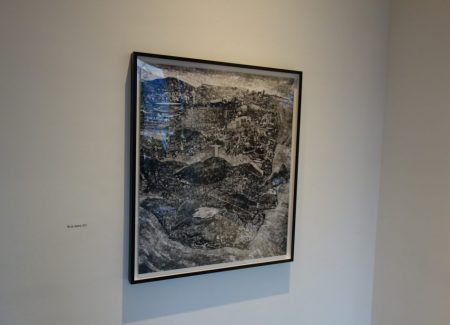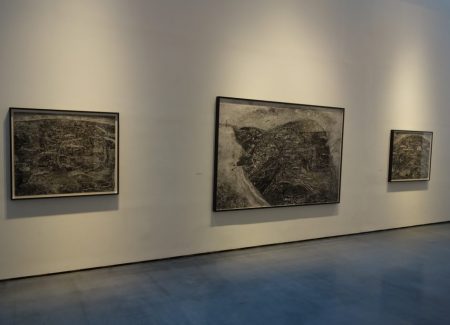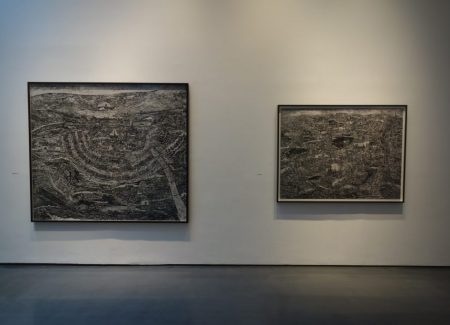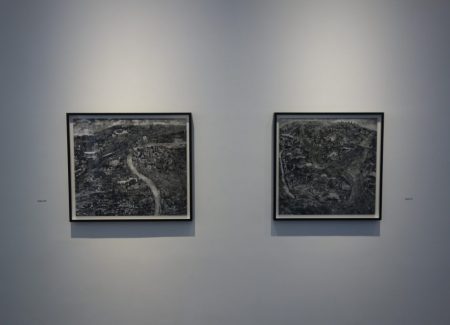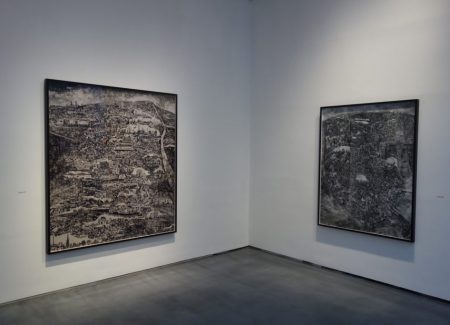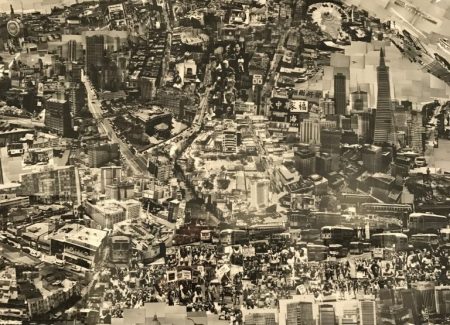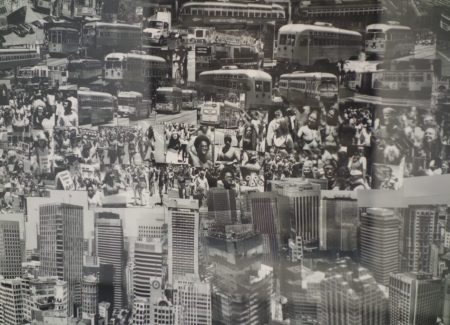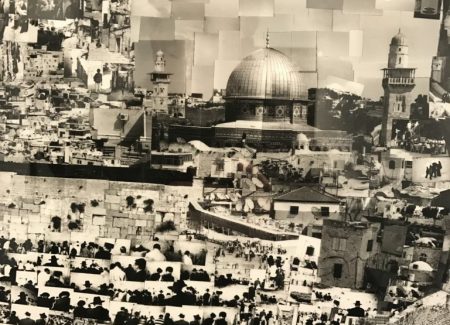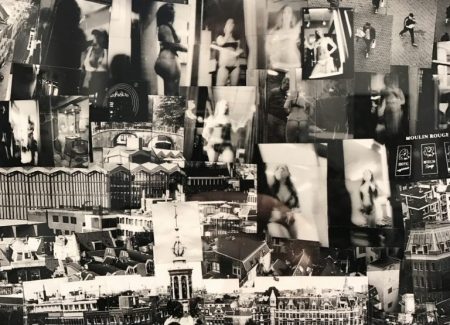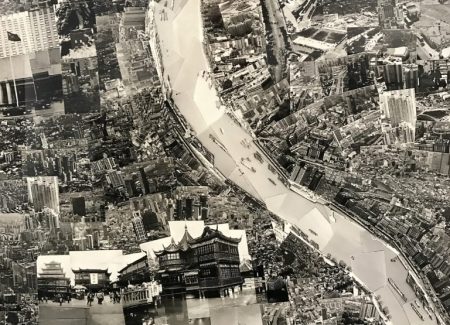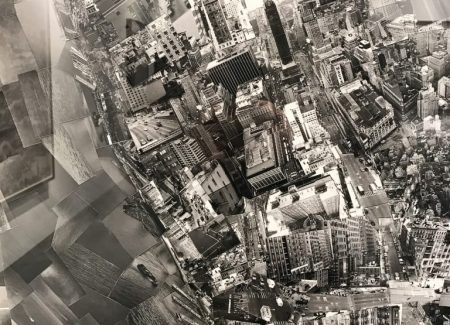JTF (just the facts): A total of 11 black-and-white large-scale photographs, framed in black and unmatted, and hung against white walls in the main gallery space in back and in the front foyer. All of the works are light jet prints on Kodak Endura paper, made between 2004 and 2016. Physical sizes range from 31×35 inches to 70×106 inches. About half of the prints are produced in editions of 5, the other half in editions of 15. (Installation shots below.)
Comments/Context: Sohei Nishino’s dioramic maps of the world’s major cities have cross-over appeal. Children and adults alike can lose themselves in the swirl of obsessive detail while trying to locate familiar landmarks—Central Park in New York, the Cristo Redentor statue in Rio de Janeiro, the Hellespont in Istanbul, the Siegessäule in Berlin. They’re like “Where’s Waldo?” for cartography geeks.
The works are enlivened by numerous dualities. With their silver-gray burnished tones, they look from afar like 17th century engravings, views of foreign cities aimed at a prosperous clientele of Dutch shipping magnates or British royals. Only at a close distance can you appreciate that each picture is a photographic composite tweezed together from thousands of smaller photographs. Nishino has managed to evoke eras of map-making before photography while at the same time relying entirely on photographic optics and materials.
All of these works maintain a tension between a medieval topography—undulating, irregular, psychological, pre-scientific—and crowded scenes of buildings, streets, people, and water-borne life that are recognizably of our time. As urban compasses, Nishino’s maps are useless. As documents they are only indirectly telling as historical evidence. Marked as much by his creative hand as by the picture machine he uses, they’re valuable mainly as art objects. His skills are those of the quilt-maker, not the geographer.
The maps are also records of his walks through these places. He begins each project by going to the highest point in a city, then heads out each day with a local map, sometimes with companions, often alone. Chance and whim often guide his meanderings. It’s a method that allies him with land artists, such as Hamish Fulton and Richard Long, as well as the exploratory tradition of street photography.
Stubbornly retro, Nishino continues to shoot with film in 35 mm. and tries not to waste a single frame. Each map is composed from upwards of 10,000 photographs, which he prints as contact sheets, snips into pieces and fastens to a board. The finished print of the physical composite is shot and processed digitally—another duality.
As photo-collages, Nishino’s busy craftsmanship recalls Paul Citroen’s and Hannah Höch’s as well as the photo-mosaics of the moon from the Surveyor Missions. That short-lived NASA program (1966-67) used machine-mounted cameras to map the lunar landscape in preparation for the manned landing of the Apollo Missions.
The show at Wolkowitz, like the one now at SFMOMA (linked in the sidebar), is a mini-retrospective of Nishino’s development over 12 years. In his latest maps here—New Delhi (2013), Amsterdam (2014), Havana (2015), and San Francisco (2016)—the size of the tiny photographs is less uniform. He has allowed himself more freedom to exaggerate the scale of certain features and sectors of the cities, albeit in miniature. The sex workers in the windows of De Wallen’s Red Light District are almost as prominent as the canals ringing the city center. The Golden Gate Bridge is like a withered, vestigial tail compared to the Transamerica Pyramid. The faces of individuals in Chinatown are crowded together and are as large as the cable cars or the boats leaving the Embarcadero.
His embroidered and meticulous style, though, has remained consistent. Each map is an elaborate undertaking that has obviously cost him time and effort. (One can guess that not every neighborhood of these cities was a delight to traverse and photograph.) The satisfactions of puzzle solving, of finding a place for every stray piece on the board, are evident.
Maps are designed to assert order over confusion. Nishino’s may be looser and less imposing that a National Geographic atlas but no different in their calming effect. They’re full of bourgeois pleasures, antidotes to urban anomie. In every inch of his Berlin or Tokyo, we’re asked to share his tactile delight in trees, hills, bicyclists on the streets and pedestrians along the riverbank, as well as to orient ourselves—as he did—via the tourist monuments. At a micro-level, his photographs are surprisingly textured. Water in his prints assumes various unpredictable guises; it may have the thin striations of wood grain, or be foamy white like new chalk, or flat and gray, or tightly meshed like chain mail.
That said, a dutiful sameness can begun to percolate through the aquifer, a problem that isn’t solved by increasing the size of the print or the intricacy. Nishino has said in interviews that these maps are personal, a trait that could be more apparent.
Their popularity shouldn’t be held against them but no doubt will be in some quarters. Perhaps he needs to map cities that aren’t cultural capitals or don’t hold air fairs. He has already proven himself to be a champion walker—as restless and curious as Restif de la Bretonne, Henry David Thoreau, Philip Lopate, or Rebecca Solnit. Maybe if he applied his photo-mapping skills to a place where he isn’t a stranger—the Japanese village where his ancestors grew up?—unexpected emotional layers would bubble up. Maps have never been entirely neutral documents. Their reality as political objects, and sources of conflict, is notably missing from his catalog so far. Its scope could be enlarged by a more diachronic and pointed perspective.
Collector’s POV: The prints in this show range in price from $11050 (for the map of Shanghai) to $68900 (for the map of New York). Nishino’s work has little secondary market history at this point, so gallery retail remains the best option or those collectors interested in following up.


